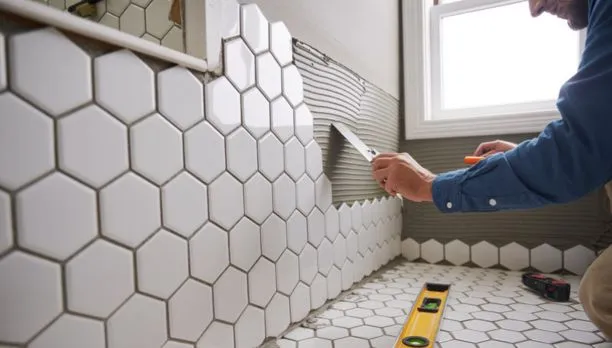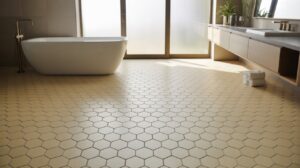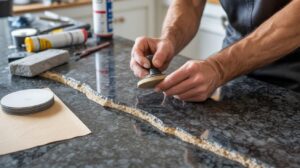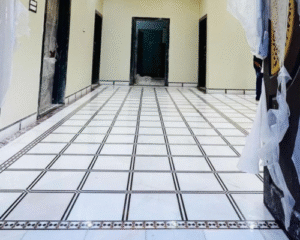Basics of hexagon tiles are becoming increasingly important for homeowners and designers looking to add a stylish, geometric flair to their interiors. These six-sided tiles offer a perfect blend of tradition and modernity, often used in backsplashes, bathroom floors, and feature walls. Whether you’re planning a kitchen update or a full bathroom remodel, understanding the shapes, sizes, materials, and layout patterns of hexagon tiles can help you make smarter design choices from the start.
At SF Marble and Granite Inc., we specialize in premium tile and stone installations across Lowell, MA, including eye-catching hexagon tile applications. With over a decade of experience in marble flooring, granite countertops, and backsplash installation, we help clients explore not just the look but also the function and long-term value of hexagon tile designs. This guide will walk you through the essential aspects to know before choosing hex tiles for your next project.
Table of Contents
ToggleWhat Are Hexagon Tiles?

The basics of hexagon tiles start with understanding their unique shape and style. A hexagon tile has six equal sides and fits together in a honeycomb pattern. This layout adds texture and a modern feel to any surface, whether it’s a kitchen wall or a bathroom floor.
At SF Marble and Granite, we help homeowners in Lowell choose hexagon tiles that match their space, budget, and design preferences.
Hexagon tiles come in different materials. Each type has its use and finish.
- Ceramic is affordable and best for walls
- Porcelain is stronger and works well on floors
- Marble gives a luxurious, timeless look
- Natural stone adds texture and warmth
- Glass or metal is good for modern accents
They also come in various sizes and thicknesses. Smaller tiles are used for tight spaces or detailed work, while larger tiles cover wide areas with fewer grout lines.
- Small (1 to 3 inches) for mosaics and showers
- Medium (4 to 6 inches) for backsplashes and floors
- Large (7 inches and up) for open areas
Most hex tiles are between 6 mm and 10 mm thick. Thicker tiles last longer, while thinner ones are easier to install on walls.
History and Design Significance
The basics of hexagon tiles go back to ancient times. These six-sided tiles were used in Roman floors and became popular in Europe for their strong, balanced look.
Historical Origins
- Used in Roman and Victorian designs
- Known for strength and style
- Common in old homes and public buildings
Why Hexagon Tiles Work
Hex tiles fit tightly together, making surfaces smooth and clean. They add shape and texture without being too bold.
- Great for small or large areas
- Easy to mix with other styles
- Looks neat and eye-catching
A hexagon backsplash kitchen adds a modern touch while staying timeless.
Timeless and Trendy
Hex tiles work with many materials, including stains out of thick grey marble. This makes them perfect for classic or trendy spaces.
- Never out of style
- Adds value and elegance
- Works in both old and new homes
At SF Marble and Granite, we help you use the basics of hexagon tiles to design beautiful and lasting spaces.
Popular Areas to Use Hexagon Tiles
The basics of hexagon tiles make them perfect for many spaces. Their clean lines and flexible design work well in both classic and modern homes.
Kitchen Backsplashes
A white hexagon tile gives kitchens a fresh, clean look. It pairs nicely with wood, stone, or vertical shiplap.
- Easy to wipe clean
- Modern yet timeless
Bathroom Floors and Walls
Hex tiles offer style and safety in wet areas. They go well with natural materials, like sealing a marble floor.
- Slip-resistant
- Great for shower floors and walls
Entryways and Accent Walls
Use hex tiles to highlight a space or create a custom medallion layout.
- Adds visual interest
- Makes small spaces stand out
Outdoor Patios
Hex tiles also work well outside. With proper sealing, they last long and look great.
- Durable for the weather
- Ideal for walkways or sitting areas
At SF Marble and Granite, we use the basics of hexagon tiles to help you design spaces that are stylish and built to last.
Types of Hexagon Tiles by Material
Understanding the basics of hexagon tiles means knowing the materials they come in. The right material affects how your tiles look, feel, and perform in everyday use. Whether you’re updating your kitchen or removing old flooring, the choice matters.
Marble Hexagon Tiles
Marble brings elegance and a natural stone finish to any space. It works especially well in bathrooms and entryways where you want luxury. Pairing hexagonal tile flooring with warm touches like wood or butcher block countertops creates a balanced, high-end look.
- Natural veining and texture
- Timeless and classic
Porcelain and Ceramic Hexagon Tiles
Porcelain and ceramic are top picks for kitchens and bathrooms. They’re easy to clean and come in many styles, from simple matte to bold patterns.
- Great for high-moisture areas
- Affordable and durable
Natural Stone vs. Manufactured Tiles
Natural stone like slate, travertine, or marble has a unique texture and color. Manufactured tiles, like glazed ceramic or porcelain, offer more consistent finishes and lower maintenance.
- Natural stone gives a rustic, earthy look
- Manufactured tiles are uniform and budget-friendly
We help you choose the right material based on your style and space. With the basics of hexagon tiles in mind, picking the best fit for your flooring or backsplash becomes much easier.
Pros and Cons of Hexagon Tiles
When exploring the basics of hexagon tiles, it’s helpful to weigh the benefits and drawbacks. Hex tiles offer a stylish upgrade to floors and walls, but like any material, they come with pros and cons.
If you’re planning a kitchen makeover and searching for quartz countertops near me, consider pairing them with hex tiles for a complete and modern look.
Quick Look: Pros and Cons of Hexagon Tiles
Pros | Cons |
Strong and long-lasting | Requires more grout lines |
Unique and stylish design | Installation needs precision |
Fits many design styles | Can cost more than standard tiles |
Works on walls and floors | Needs regular grout maintenance |
Hexagon tiles are beautiful and durable, but need careful installation to look their best. At SF Marble and Granite, we guide you through the basics of hexagon tiles so your project turns out exactly how you imagined, clean, stylish, and built to last.
Installation Basics
Part of understanding the basics of hexagon tiles is knowing how important proper installation is. Because of their geometric shape, hex tiles need careful planning to look clean and even.
Surface Preparation
Before placing tiles, the surface must be flat and dry. Any bumps or dips can throw off the pattern. Whether it’s a backsplash or flooring, a smooth surface is key to a flawless finish.
Precision in Layout
Hex tiles fit together tightly. Even a small mistake in layout can make the pattern look off. That’s why lining them up with exact spacing from the start is important, especially in detailed areas like behind stove spaces or corners.
If you’re choosing darker tiles or planning to hang shelves above them, alignment becomes even more noticeable.
Why Choose SF Marble and Granite Inc.
When it comes to turning design ideas into reality, having the right team matters. At SF Marble and Granite Inc., we bring years of experience to every project, especially with detailed work like backsplash designs, marble floor installation, and hex tile layouts.
We understand the basics of hexagon tiles better than most. From tile selection to layout and finishing touches, our team ensures each tile is placed with precision. Whether you’re renovating a small bathroom or adding a new kitchen backsplash, we help you choose materials that match your vision and last for years.
Our tile options are fully customizable, allowing you to mix colors, finishes, and patterns to suit your space. And as a trusted name in Lowell, MA, homeowners count on us for professional service, honest advice, and lasting results.
Final Thought
The basics of hexagon tiles show just how versatile and beautiful this timeless shape can be. Whether you’re designing a bathroom floor, a kitchen backsplash, or a unique accent wall, hex tiles bring character, style, and function to any space. At SF Marble and Granite Inc., we specialize in expert tile installations, including custom layouts and material selection. Ready to start your project? Contact SF Marble and Granite Inc. today for professional guidance and flawless results.
FAQs
What are the basics of hexagon tiles for beginners?
Hexagon tiles are six-sided tiles that fit together in a honeycomb pattern. They come in various sizes and materials like ceramic, porcelain, and marble. They’re popular for floors, backsplashes, and accent walls because of their clean look and flexible design options.
Are hexagon tiles hard to install compared to regular tiles?
Yes, hexagon tiles need more precision during installation due to their shape. Proper layout and spacing are key to keeping the pattern aligned. That’s why many homeowners trust experts like SF Marble and Granite Inc. for accurate and smooth results.
Where can hexagon tiles be used in my home?
Hexagon tiles work well in kitchens, bathrooms, entryways, and even outdoor patios. They’re especially popular for backsplashes, shower floors, and decorative wall accents. Whether you prefer bold or subtle looks, they fit many styles and spaces.







